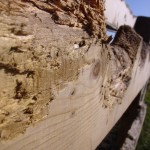Cribbing in Horses: Everything You Need to Know

Cribbing, the process of a horse biting down on a stationary wooden structure, applying pressure and then breathing in deeply, can be destructive to more than just your barn and stalls!
While cribbing has traditionally been thought to be just a vice or bad habit, new information indicates that a horse that cribs may be responding to a digestive upset. The act of cribbing produces excess saliva. This saliva helps to buffer the stomach and can calm the pain of things like ulcers and other digestive problems.
If you have a horse that cribs, the first step should be determining why the problem started. This may very well include a trip to the vet to rule out gastric ulcers or digestive issues. In cribbers who are diagnosed with ulcers, the behavior often stops or is reduced when treatment for the ulcers is started. Cribbing can also be caused by extreme boredom and is usually associated with horses who spend most of their time in stall situations.
Causes of Cribbing in Horses
It is important to note that cribbing is not a learned behavior – horses don’t start cribbing because they see their stablemates doing it. Rather, in a group of horses that all begin to crib the catalyst may be management practices that lead to some type of gastric distress. Some of these practices that can lead to cribbing include:
- Not providing enough long stemmed forage
- Feeding large grain meals all at one time
- Not providing a properly balanced diet
- Not giving adequate access to salt
- Inadequate turn out time
Understanding The Cribbing Behavior
The bad news is that once a horse has started cribbing, it can be a hard habit to break. As the horse bites down on the wood and inhales, endorphins are released that can give the animal a “high”. That is why it can be very difficult for the horse that has started cribbing to stop – they get addicted to what it does to their body. Unfortunately, cribbing is a very good way to cause colic (as well as destroy property), so all possible steps should be taken to end the behavior.
Breaking the Cribbing Habit:
Once the source of the cribbing is confirmed and addressed, some recommendations to help stop the behavior and break the addiction can include:
- Adequate long stemmed forage provided throughout the day
- Plenty of turn out time with opportunities to interact with other horses
- Stall toys to help ease boredom
- Placing feed in multiple locations around the pen to make the horse mimic his natural grazing behavior
- Feeding grain meals in small amounts several times per day rather than all at once
- Providing a balanced diet
- Giving ample access to loose white salt
- Using a special cribbing collar or strap
- Covering wooden surfaces with anti-chew paint
Treating the cribbing horse can be a challenge, but remember that the first step is figuring out why the problem started. Your horse’s cribbing may just be his way of telling you that he is in pain and needs your help.
